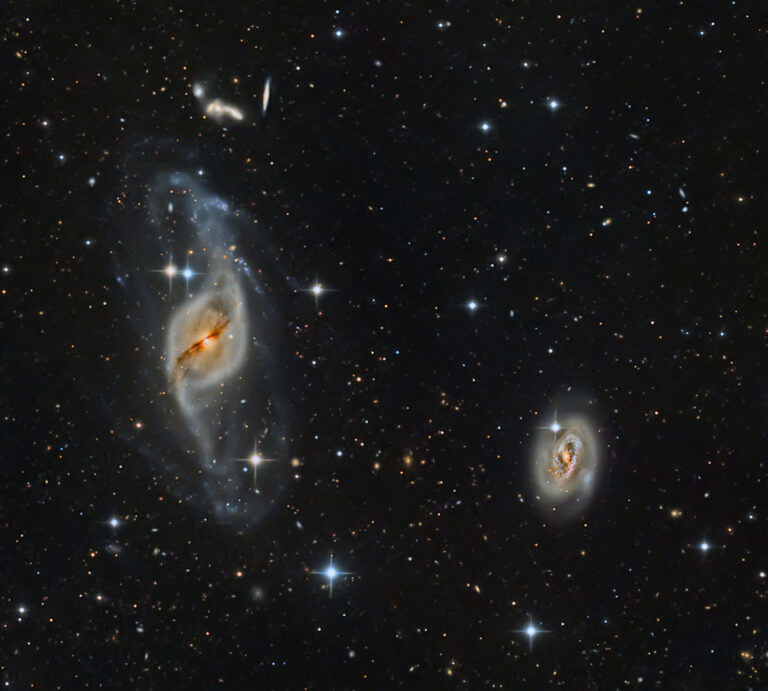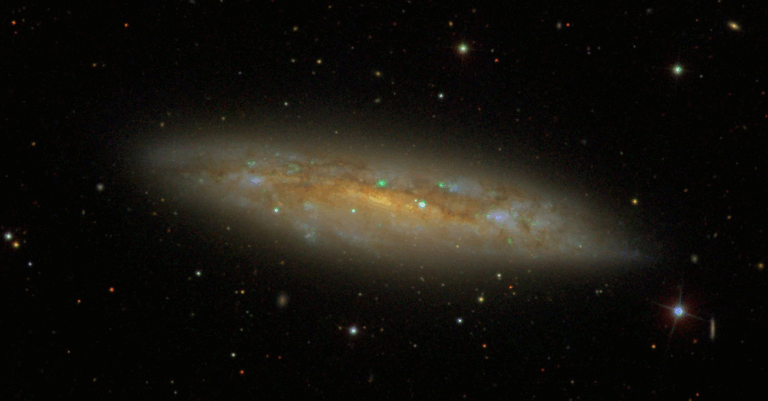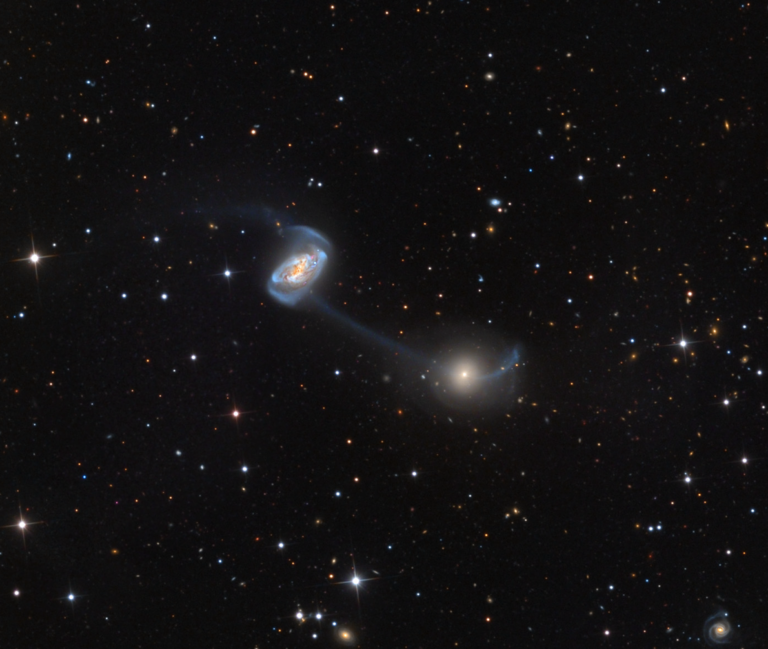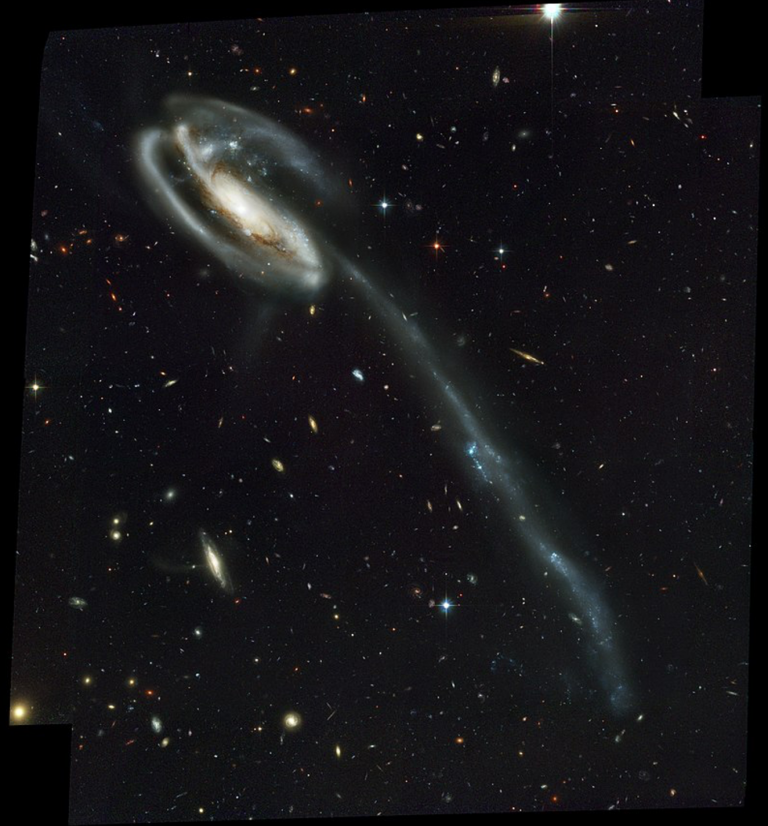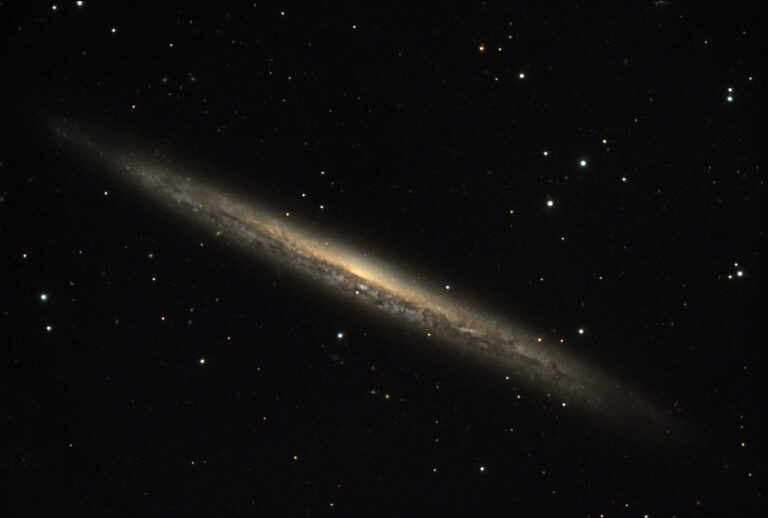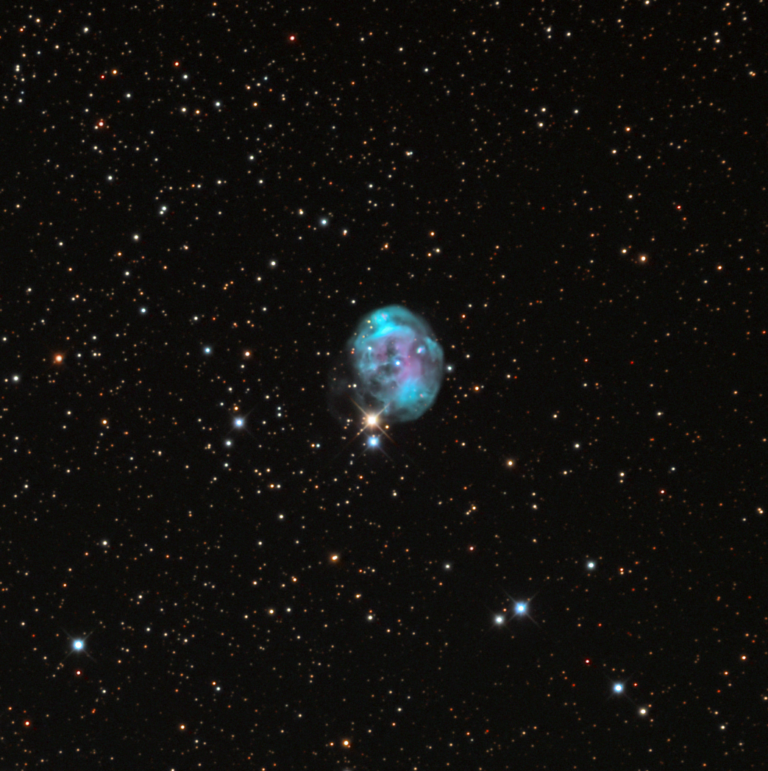Key Takeaways:
Targets for May 26–June 2, 2016
Naked eyes: Cor Caroli (Alpha [α] Canum Venaticorum)
Small telescope: The Pearl Cluster (NGC 3766)
Large telescope: The Leo Triplet
This week’s naked-eye object is Cor Caroli (Alpha [α] Canum Venaticorum), the brightest star in the northern constellation Canes Venatici the Hunting Dogs. It shines at magnitude 2.8, but the constellation it belongs to is faint. So, just look 17.5° due south of Alioth (Epsilon [ε] Ursae Majoris) in the Big Dipper’s handle.
Once you identify it visually, point a telescope at Cor Caroli, and turn one star into a pretty stellar pair. The brighter primary shines blue-white at magnitude 2.9. That provides a nice color-contrast to the yellow secondary, which glows at magnitude 5.5. Because the brighter of the pair outshines the fainter by only a factor of 11, and because the separation between the two stars is 19″, this is a great sight through a small telescope. And in the spring, it’s one of the most viewed double stars at star parties.
Prior to 1725, this star was known as the Lion’s liver. In that year, however, British Astronomer Royal Edmond Halley designated it Cor Caroli (the heart of Charles), in honor of Charles II, England’s king.
In 1899, Richard Hinckley Allen wrote in Star-Names and Their Meanings that Halley did this at the suggestion of court physician Sir Charles Scarborough, who said the star had shone with special brilliancy on the eve of the king’s return to London, May 29, 1660.
A southern sky pearl
This week’s small-telescope target is the Pearl Cluster, also known as NGC 3766, an open star cluster in Centaurus. You’ll find this object 1.5° north of Lambda (λ) Centauri, and what a sight it is. If your travel plans include the Southern Hemisphere in the future, I strongly suggest you put NGC 3766 on your observing list. You’ll thank me.
Now, here’s a bit of trivia about this object: It received its common name, the Pearl Cluster, February 15, 2006, from amateur astronomer and popularizer Ray Palmer. On that date, he founded the South Celestial Star Light Project to help fine-tune the names of Southern Hemisphere celestial objects. His reasoning is that astronomy must appeal to everyone, not be complicated or boring. People (especially youth), Palmer theorizes, will remember and relate to a sky object’s popular name more than any of its catalog designations. I agree, and I’ll be calling NGC 3766 the Pearl Cluster from now on.
At magnitude 5.3 and a diameter of 12′, you can see this cluster without optical aid, but you’ll have to work at it because of the rich star field it’s in. Binoculars, especially those that magnify 15x or more, will reveal dozens of stars. But the finest view comes through a telescope that magnifies between 75x and 100x.
Through a 4-inch scope, you can count 100 stars, the brightest of which shines at 7th magnitude. That number in itself provides a sweet view, but there’s more. Riding seemingly in front of a pure-white carpet of diamonds are two pale rubies. One, magnitude 7.5 SAO 251483, lies midway between the cluster’s center and its eastern edge. The other, magnitude 7.3 SAO 251470, lies the same distance from the center toward the west. Indeed, the Pearl Cluster is a Southern Hemisphere jewel.
Observe one, get two free
This week’s large-telescope target is the Leo Triplet, a triangular group of galaxies — M65, M66, and NGC 3628 — in Leo the Lion.
Draw a line from magnitude 3.3 Chertan (Theta [θ] Leonis) to magnitude 4.0 Iota (ι) Leonis. At the midpoint of that line, you’ll find the terrific spiral galaxy M65. Another way to find it is to venture 0.8° east-southeast of the magnitude 5.3 star 73 Leonis.
Magnitude 9.3 M65 anchors the Leo Triplet’s southwestern corner. M65 appears nearly four times as long as it does wide, measuring 8.7′ by 2.2′. Spiral structure is difficult to discern, but you’ll see some mottling north and south of the galaxy’s broad core.
From M65, move only 0.3° east-southeast to find an even brighter celestial wonder, M66, the second galaxy in the Leo Triplet. It shines at magnitude 8.9. Through a 6-inch telescope, this spiral galaxy looks hazy and twice as long as it is wide — 8.2′ by 3.9′ — oriented north-south. A brighter central region dominates the view.
An 11-inch scope at 200x reveals a hint of the galaxy’s spiral arms. Look for a hook-shaped feature pointing northeast from the southern end of the bar. The corresponding feature at the northern end is more difficult to see, so crank the magnification past 300x.
Larger telescopes show the spiral arms dotted with star-forming regions as well as a dark lane east of M66’s central region. Through any scope, the galaxy has a well-defined edge.
A third spiral galaxy called King Hamlet’s Ghost or the Vanishing Galaxy rounds out the Leo Triplet. Although it glows more faintly than the Triplet’s two Messier objects, NGC 3628 still ranks as one of the sky’s brightest galaxies. It shines at magnitude 9.5 and measures 14′ by 4′. From M65, nudge your telescope 0.6° northeast to center this fine object.
This edge-on starburst galaxy resembles the Cigar Galaxy (M82) in Ursa Major. Astronomers theorize that NGC 3628 had an encounter with M66 800 million years ago, when the two galaxies were only 80,000 light-years apart.
Through an 11-inch telescope, you’ll see a bright object 4 times as long as it is wide. A dust lane runs the galaxy’s entire length. It crosses south of the center and is not parallel with the long axis. Through a 24-inch scope, the galaxy’s ends appear thicker than the central region.
Astronomy magazine Contributing Editor Stephen James O’Meara gave NGC 3628 both of its common names. I like his reasoning for calling it the Vanishing Nebula. With each increase in magnification, he saw the galaxy blending more and more into the background. The reason he gives for that effect is that the galaxy’s dust lane overwhelms the stars around it as he increases the telescope’s power.
O’Meara, a lover of Shakespeare, also called this galaxy King Hamlet’s Ghost. To O’Meara, observing it through a small telescope, it resembled what Prince Hamlet must have seen when his father’s ghost appeared to him.
Expand your observing at Astronomy.com
The Sky this Week
Get a daily digest of celestial events coming soon to a sky near you.
Observing Basics
Find more guidance from Senior Editor Michael E. Bakich with his Observing Basics video series.



